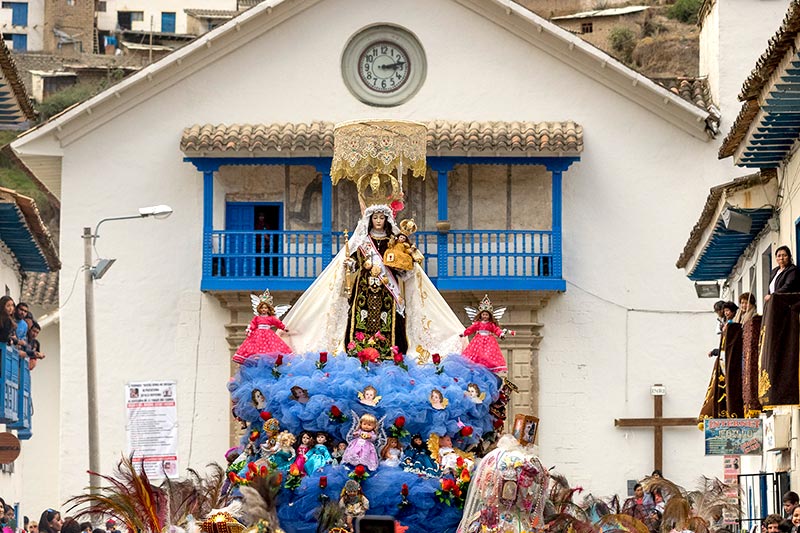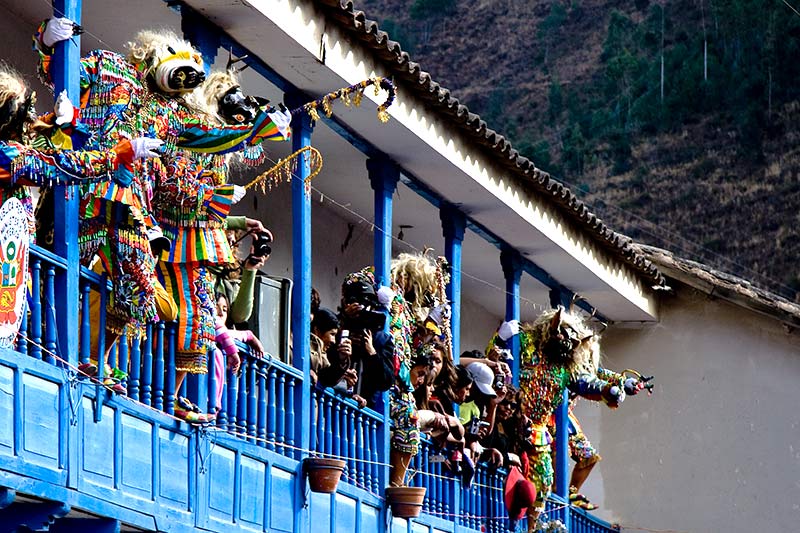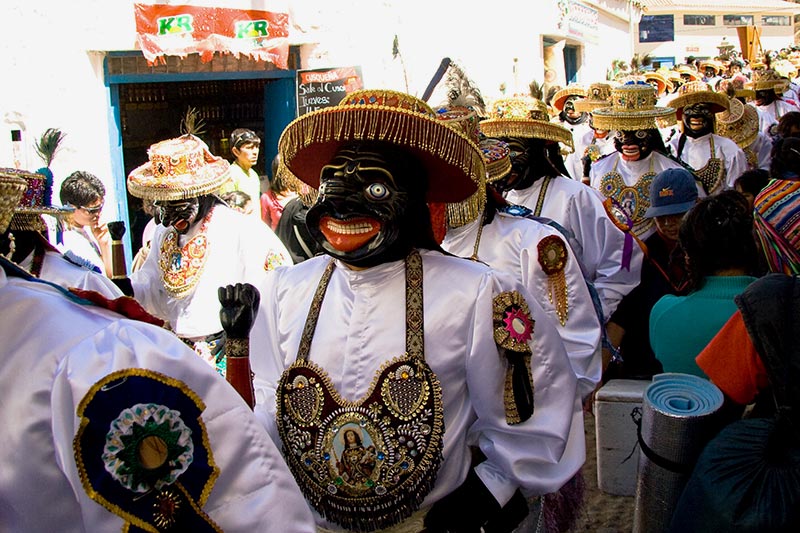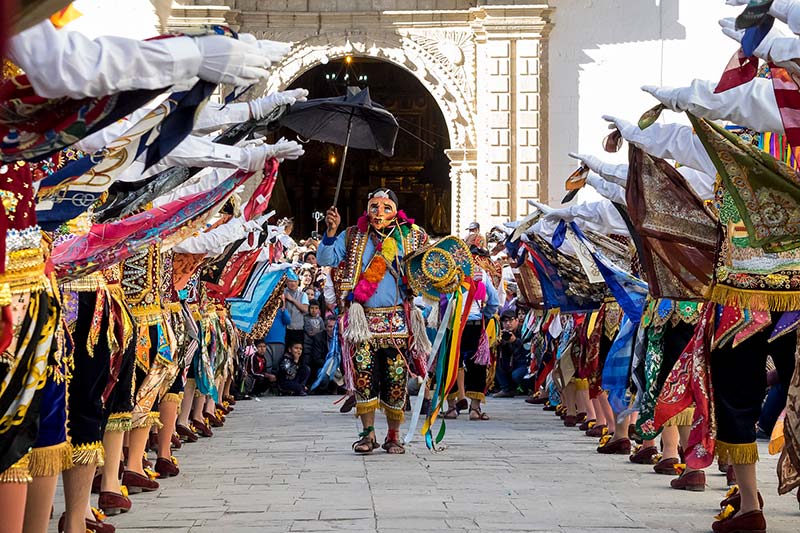Feast of the Virgin of Carmen in Paucartambo
One of the most iconic festivals in the city of Cusco is the one that honors the Virgin of Carmen in Paucartambo. During this celebration, we witness a privileged view of Andean culture that brings together thousands of people in an environment full of dance, color, music, festivity, and devotion. If you visit Cusco in July, don’t miss the chance to experience this incredible festival in a truly magical town that will immerse you in one of the most impressive traditions in all of Peru.
- Virgin of Carmen Festival
- When is the Virgin of Carmen festival celebrated?
- Where is Paucartambo?
- What is the Virgin of Carmen celebration like?
- What dances will I see in Paucartambo?
- The 3 Crosses Viewpoint in Paucartambo
- What other places celebrate the Virgin of Carmen?
- Tips for your visit to Paucartambo
- Frequently Asked Questions
Virgin of Carmen Festival
The celebration of the Virgin of Carmen is one of the most important religious festivals in Peru. It takes place every year from July 15 to 18, with the main day being July 16. It has been commemorated since colonial times, gaining great religious and cultural significance as it merged with Andean traditions.
“La Mamacha Carmen”, as the Virgin is culturally known, brings together thousands of devotees across different regions of Peru in a celebration that honors the Virgin through songs, colors, and dances — featuring everything a grand Andean religious festival usually offers.
Paucartambo is the town that conveys the most tradition and joy to all its visitors during these festive days. Being a small town, everything is within reach, allowing you to explore it fully and enjoy each of its iconic corners.
For more than four days, many activities enrich your visit, including religious ceremonies, civic events, festive gatherings, and the popular traditional dances — one of the main highlights that make visiting the magical town of Paucartambo so memorable.
Discover Cusco During the Dry Season
Cusco’s dry season lasts from April to October, offering the best weather conditions to explore any destination without issues. If you’re traveling to Cusco in July, don’t miss the chance to visit Paucartambo and experience the traditional Virgin of Carmen festival, where you’ll immerse yourself in Andean culture. You’ll also get to visit the impressive “Three Golden Crosses” viewpoint — an absolute delight. Remember, you can book tours throughout Cusco with Boletomachupicchu, so you don’t miss out on the best time of year in the ancient Inca city. Machu Picchu, the Sacred Valley of the Incas, Humantay Lake, Rainbow Mountain, and more destinations await you.
When is the Virgin of Carmen Festival Celebrated?
The main day of the Virgin of Carmen festival is July 16 throughout Peru, but the festivities begin a few days earlier, with the main events taking place from July 15 to 18.
Where is Paucartambo?
The province of Paucartambo is located in the department of Cusco. To get there, you travel approximately 110 kilometers, taking about 2 hours and 30 minutes from the city center.
What is the Virgin of Carmen Celebration Like?
The festival of “Mamacha Carmen” takes place from July 15 to 18 with religious and civic celebrations that fill the entire town of Paucartambo with color. During the main days, the following activities take place:
- July 15: The festival begins with the arrival of the 19 traditional dance groups, followed by a mass where offerings are made to the Virgin of Carmen. At night, there is a fireworks display in the main square, along with the popular beginning of the Alba, or greeting to the Virgin, closing the day on a high note.
- July 16: The main day begins early with the central mass and the entrance of the dance groups. In the afternoon, lunch is offered by the main sponsor (“cargo mayor”), followed by the central procession of the Virgin of Carmen, accompanied by the dances and devotees throughout the town of Paucartambo. At night, celebrations are held in the houses or “cargos” of each dance group and in the main square.
- July 17: Like the other days, the morning begins with a mass. Then, there is a visit to the cemetery of Paucartambo and a small procession of “Mamacha Carmen.” In the afternoon, the popular guerrilla takes place — a theatrical performance in the main square involving all the dance groups. At night, traditional parties continue throughout the town.
- July 18: On this day, the Virgin of Carmen makes her final outing accompanied by a mass. At dusk, the traditional “Kacharpari” takes place, where the dances parade through the streets and the main square with a musical band, filling every corner of Paucartambo with joy.
What Dances Will I See in Paucartambo?
One of the main attractions of the Virgin of Carmen festival in Paucartambo is its traditional dances. There are 19 in total, and each one represents a story or traditional legacy. Throughout the “Mamacha Carmen” festival, you will see them devoted and present, adding vibrant color and joy to the celebration.
| DANCE | REPRESENTATION |
|---|---|
| Qhapaq Chunchu | Warriors and inhabitants of the Amazon jungle. |
| Qhapaq Qolla | Highland traders. |
| Qhapaq Negro | Slaves brought from the coast. |
| Saqra | Spirits of Andean demons. |
| Siklla (Doctorcito) | Parodied judicial authorities. |
| Auqa Chileno | Chilean soldiers from the War of the Pacific. |
| Majeño | Muleteers from the Majes Valley (Arequipa). |
| Qoyacha | Dance celebrating love among singles. |
| Ch’unchachas | Exotic and warrior women from the jungle. |
| Chucchu | Hacienda workers affected by malaria. |
| Danzaq | Conquerors and seducers of women. |
| Waca Waca | Representatives of the traditional bullfight. |
| Negrillos | Children of slaves working in agriculture. |
| K’achampa | Andean warriors from the Inca expansion. |
| Contradanza | Satirical formal dance and agricultural work. |
| Panaderos | Village bakers. |
| Misti Qanchi | Agricultural work and romantic representation with Pachamama (Mother Earth). |
| Maqt’a | Joyful jesters and festival promoters. |
| Paucartampus | Farmers from the countryside in Paucartambo. |
The Three Crosses Viewpoint in Paucartambo
One of Paucartambo’s top attractions, aside from the cultural celebration of the Virgin of Carmen, is the “Three Crosses” viewpoint — a natural observatory offering a panoramic view of the sunrise over the Cusco jungle.
The Three Crosses viewpoint is located in the village of Challabamba, in the province of Paucartambo, about 105 kilometers from the city of Cusco. From this spot, you can witness a natural phenomenon called the “white ray” or “three suns,” where, like a mirage, multiple suns appear in the sky.
The site is surrounded by an almost mystical aura, and you need to visit in the early morning hours to witness the breathtaking sunrise.
The best time to visit the Tres Cruces de Oro viewpoint is at the end of June, but with a bit of luck, you might experience a similar sunrise around the days of the Virgin of Carmen celebration.
What Other Places Celebrate the Virgin of Carmen?
The Virgin of Carmen festival is a tradition celebrated throughout Peru, but over the years, its fervor has become especially strong in the Cusco region. If you’d like to learn more about this custom and the places where it’s celebrated, here are a few examples:
- The Virgin of Carmen in Pisac
The town of Pisac, one of the best places to experience the Virgin of Carmen celebration, is located in the Sacred Valley of the Incas, 45 minutes from Cusco city. In Pisac, you’ll find a deeply devoted community celebrating the Virgin from July 15 to 18. While visiting this festival, you can also enjoy its beautiful Inca archaeological site and a bohemian town full of culture and tradition that offers a truly immersive experience. - The Virgin of Carmen in Huarocondo
The Virgin of Carmen celebration in Huarocondo takes place in the district of the same name, in the province of Anta, about 1 hour and 30 minutes from Cusco. Festivities here begin in mid-July and extend over several days. Huarocondo is a small town rich in traditional culture — a must-visit for its delicious cuisine, beautiful landscapes, and of course, its vibrant celebration of the Virgin of Carmen.
Tips for Your Visit to Paucartambo
- Paucartambo is considered a magical town; you can explore it entirely without missing a single detail.
- Visit the Tres Cruces de Oro viewpoint to enrich your experience in Paucartambo.
- Each dance holds deep tradition—don’t miss seeing them, as they will bring much joy to your experience.
- Bring warm clothing since the temperature in Paucartambo tends to drop significantly at night.
- Staying for the three main days of the celebration will allow you to truly experience Andean and Cusqueñan cultural traditions.
- Book your accommodation in Paucartambo months in advance, as they tend to sell out quickly.
- Take time during your travels to pause and fully appreciate every angle of Cusco’s destinations, so you can feel more present in your visit.
- Spend the first few days acclimating in Cusco—this is key to ensuring your trip goes smoothly and helps prevent altitude sickness.
- Take advantage of the chance to explore Paucartambo and disconnect from your routine, reflecting amidst beautiful places filled with tradition.
Frequently Asked Questions
1) On what dates is the Virgin of Carmen festival held in Paucartambo?
The festival takes place from July 15 to 18, with the main day being July 16. During these days, religious, cultural, and festive activities take place throughout the town of Paucartambo.
2) What does “Mamacha Carmen” mean?
“Mamacha” is an Andean expression of affection and respect meaning “little mother.” “Mamacha Carmen” is the name by which the Virgin of Carmen is popularly venerated in the Cusco region.
3) How do you get to Paucartambo from Cusco?
You can get to Paucartambo from the city of Cusco by traveling approximately 110 km, in a 2-hour and 30-minute road journey. It is accessible by private vehicle or public transportation.
4) What are the main activities during the festival?
The main activities are:
- July 15: Arrival of dance groups, mass, and salute to the Virgin with fireworks.
- July 16: Main mass, procession of the Virgin, and public celebration.
- July 17: Mass, cemetery visit, staged guerrilla in the main square, and night festivities.
- July 18: Final outing of the Virgin, mass, and the Kacharpari.
5) How many dances participate and what do they represent?
Nineteen traditional dances participate, each with deep cultural and historical meaning. They represent merchants, warriors, Andean spirits, satirical figures, and agricultural workers.
6) What is the “guerrilla” in the Virgin of Carmen festival?
It’s a symbolic and theatrical performance held on July 17 in the Paucartambo main square. All the dances participate in this event, which combines satire, history, and religiosity.
7) Is it necessary to stay for all days of the festival?
While it’s not mandatory, it is recommended to attend the three main days (July 15, 16, and 17) to fully experience the cultural depth of each day.
8) Is there accommodation in Paucartambo during the festival?
Yes, but availability is limited due to the high number of visitors. Booking in advance is recommended if you want a comfortable place to stay.
9) What kind of clothing should I bring to Paucartambo?
Bring warm clothes, especially for the night, as temperatures can drop considerably.
10) What other places celebrate the Virgin of Carmen in Cusco?
Besides Paucartambo, important celebrations also take place in Pisac and Huarocondo — both full of tradition and festive activities.
11) What is the Tres Cruces de Oro viewpoint?
It is a natural observatory located in Challabamba, near Paucartambo. From there, you can witness an optical phenomenon known as the “white ray” or “three suns” at sunrise. It’s best visited between late June and early July.
Advice from people who have been there
 By: Mateo K.
By: Mateo K.“Experience in Paucartambo“
“I was amazed by how beautiful the town of Paucartambo is; it preserves so much tradition and color. But what truly took my breath away was the Tres Cruces de Oro viewpoint — an unforgettable experience if you're traveling through Cusco or visiting Paucartambo.“
By Ticket Machu Picchu – Last updated, April 29, 2025



